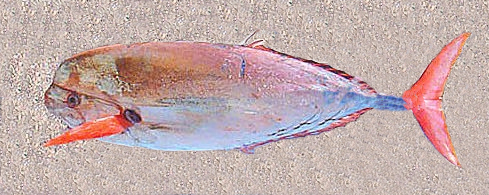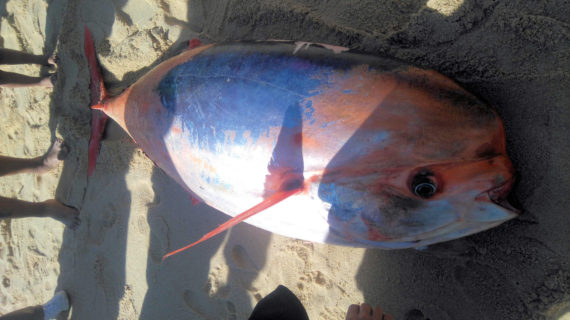Louvar, Luvarus imperialis
 Louvar, Luvarus imperialis. Fish caught off the coastal waters of the greater Los Cabos area, Baja California Sur, April 2003. Length: 91 cm (3 feet 0 inches). Weight: 16 kg (35 lbs). Photograph courtesy of Tommy Garcia, Cabo San Lucas, Baja California Sur.
Louvar, Luvarus imperialis. Fish caught off the coastal waters of the greater Los Cabos area, Baja California Sur, April 2003. Length: 91 cm (3 feet 0 inches). Weight: 16 kg (35 lbs). Photograph courtesy of Tommy Garcia, Cabo San Lucas, Baja California Sur.
 Louvar, Luvarus imperialis. Fish collected out of the surf within 50 yards of Palmilla Beach, Baja California Sur. Length: 1.52 m (5 feet 0 inches); Weight: ca. 57 kg (125 lbs) with 5.5 kg (12.1 lbs) of eggs, February 2019. Photograph courtesy of Guillermo Valadez, San José del Cabo.
Louvar, Luvarus imperialis. Fish collected out of the surf within 50 yards of Palmilla Beach, Baja California Sur. Length: 1.52 m (5 feet 0 inches); Weight: ca. 57 kg (125 lbs) with 5.5 kg (12.1 lbs) of eggs, February 2019. Photograph courtesy of Guillermo Valadez, San José del Cabo.
The Louvar, Luvarus imperialis, is the sole member of the Luvaridae or Louvar Family, that is also known as Luvar and in Mexico as emperador. It is the sole global member of the Luvarus Genus
The Louvar has elongated oval compressed body that taper to a slender caudal fin base. They are distinctively colored being metallic blue dorsally then transitioning to silver pinkish-red on their sides and silver ventrally. They are covered with indistinct dark spots on the upper two-thirds of their body. They have tinges of red and pink including red anal and caudal fins, a dorsal fin that transitions from red to dark gray, and red to yellowish pectoral fins. Juveniles are covered with dense dark spots. Their head is very deep with a convex profile and a bulging forehead. Their eyes are small and located very low on the body directly behind their small horizontal mouth. Their anal and dorsal fins are long and low both originating mid-body in similar positions. Their anal fin has 18 rays; their caudal fin is large, concave, and circular with one or two small keels at its base; their dorsal fin has 20 rays; their pectoral fins are long and pointed; and, their pelvic fins are minute. They are covered with rough skin and tiny spines. Juveniles go through a dramatic metamorphosis in the shape and size of their head and fins; for example their anal and dorsal fins are higher on the body, have longer bases than the adult versions and their pelvic fins are very long.
The Louvar is an oceanic pelagic species found from the surface to mid-water at depths up to 200 m (660 feet). They reach a maximum of 2 m (6 feet 7 inches) in length and 150 kg (330 lbs) in weight. They travel as solitary individuals and consume soft-body plankton including ctenophores, jellyfish, and salps. The Louvar is poorly studied with very limited information available about their lifestyle and behavioral patterns including specific details on age, growth, longevity, movement patterns, diet, habitat use, and reproduction.
Although widespread in tropical and temperate seas cicumglobally, in Mexican waters the Louvar is found only along the west coasts of Baja and the mainland being absent from the Sea of Cortez and the Gulf of Mexico. They are known residents of the Atlantic Ocean but have not been documented in Mexican waters.
The Louvar cannot be easily confused with any other species due to its coloration and body shape.
From a conservation perspective the Louvar is currently considered to be of Least Concern. As they are more common in the Indo-Pacific ocean, they are sold fresh or frozen on a limited basis in some of the local markets in that area of the world. They are, however, plagued with parasites and therefore not targeted by commercial fishermen for human consumption.